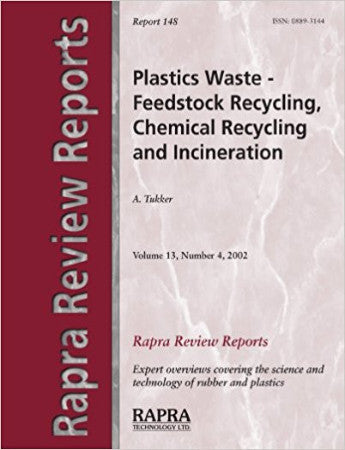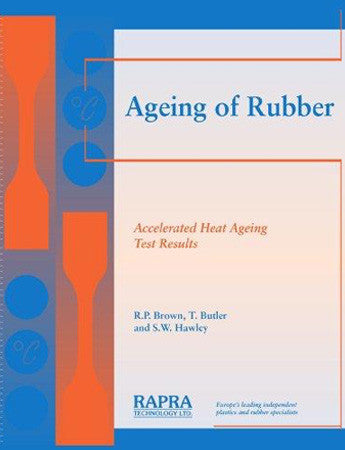Plastics Waste - Feedstock Recycling, Chemical Recycling and Incineration
Protection of our environment is now a global priority and legislation is being introduced in regions such as the European Union to ensure that material usage is maximised. Much of the development work has been pioneered in Germany which introduced very strict recycling laws. This report examines the issue of converting Plastics Waste into energy and/or useful chemicals.
Polymers are generally derived from fossil fuels which are being gradually depleted. Much plastic material is discarded as waste, such as packaging and end-of-life vehicle components. It is essential that we find means to preserve fossil fuels and to reuse materials in some form. Life cycle analysis is being performed on the different methods of disposing of waste plastics to discover the most environmentally friendly methods. Mechanical recycling is often discussed but it is limited by the need to separate and clean used plastics prior to recycling.
This report introduces the different waste management options. It discusses the methods available for treating mixed plastics waste and PVC-rich plastics waste. PVC can cause problems in some processes due to the chlorine content, which can cause corrosion of equipment and potentially generate hazardous gas on combustion. The emphasis in this report is on technologies which are already being used or assessed for use on a commercial scale. Comparisons are made between the different types of recycling currently available in terms of life cycle assessment and environmental impact.
The EU draft directive on Packaging waste includes definitions of the types of recycling. Chemical recycling implies a change of the chemical structure of the material, but in such a way that the resulting chemicals can be used to produce the original material again. Such processes include monomer recover. There are few commercial techniques available which accomplish this, one outstanding example is nylon carpet recycling.
Feedstock recycling is discussed extensively in this review. It is defined as a change in the chemical structure of the material, where the resulting chemicals are used for another purpose than producing the original material. Methods have been developed including the Texaco gasification process, polymer cracking, the BASF conversion process, the Veba Combi cracking process, BSL incineration process, the Akzo Nobel steam gasification process, the Linde gasification process, the NKT pyrolysis process and pressurised fixed bed gasification from SVZ. Typical feedstocks generated include synthesis gas, containing mainly CO and H2. By-products such as chlorides are generally sold on for other processes and slag can be used in applications such as a building. The energy released during these processes is generally used or recovered.
Alternatives to feedstock recycling include cement kilns (energy recovery), the Solvay Vinyloop PVC-recovery process, mechanical recycling, landfill and municipal solid waste incinerators (energy recovery). These processes are briefly discussed and compared to feedstock recycling as methods of disposing of plastics wastes. The commercial viability of each process is examined.
This report is accompanied by around 400 abstracts from papers in the Rapra Polymer Library. This selection includes references to feedstock and chemical recycling, but also methods of energy recovery and the Vinyloop process.
Polymers are generally derived from fossil fuels which are being gradually depleted. Much plastic material is discarded as waste, such as packaging and end-of-life vehicle components. It is essential that we find means to preserve fossil fuels and to reuse materials in some form. Life cycle analysis is being performed on the different methods of disposing of waste plastics to discover the most environmentally friendly methods. Mechanical recycling is often discussed but it is limited by the need to separate and clean used plastics prior to recycling.
This report introduces the different waste management options. It discusses the methods available for treating mixed plastics waste and PVC-rich plastics waste. PVC can cause problems in some processes due to the chlorine content, which can cause corrosion of equipment and potentially generate hazardous gas on combustion. The emphasis in this report is on technologies which are already being used or assessed for use on a commercial scale. Comparisons are made between the different types of recycling currently available in terms of life cycle assessment and environmental impact.
The EU draft directive on Packaging waste includes definitions of the types of recycling. Chemical recycling implies a change of the chemical structure of the material, but in such a way that the resulting chemicals can be used to produce the original material again. Such processes include monomer recover. There are few commercial techniques available which accomplish this, one outstanding example is nylon carpet recycling.
Feedstock recycling is discussed extensively in this review. It is defined as a change in the chemical structure of the material, where the resulting chemicals are used for another purpose than producing the original material. Methods have been developed including the Texaco gasification process, polymer cracking, the BASF conversion process, the Veba Combi cracking process, BSL incineration process, the Akzo Nobel steam gasification process, the Linde gasification process, the NKT pyrolysis process and pressurised fixed bed gasification from SVZ. Typical feedstocks generated include synthesis gas, containing mainly CO and H2. By-products such as chlorides are generally sold on for other processes and slag can be used in applications such as a building. The energy released during these processes is generally used or recovered.
Alternatives to feedstock recycling include cement kilns (energy recovery), the Solvay Vinyloop PVC-recovery process, mechanical recycling, landfill and municipal solid waste incinerators (energy recovery). These processes are briefly discussed and compared to feedstock recycling as methods of disposing of plastics wastes. The commercial viability of each process is examined.
This report is accompanied by around 400 abstracts from papers in the Rapra Polymer Library. This selection includes references to feedstock and chemical recycling, but also methods of energy recovery and the Vinyloop process.
1 Introduction
2 Plastics Waste Recycling: An Overview
3 Feedstock Recycling of Mixed Plastic Waste
3.1 Introduction
3.2 Texaco Gasification Process
3.3 The Polymer Cracking Process (Consortium Project)
3.4 The BASF Conversion Process
3.5 Use of Mixed Plastic Waste in Blast Furnaces
3.6 Veba Combi Cracking Process
3.7 SVZ Gasification Process
4 Feedstock Recycling of PVC-Rich Waste
4.1 Introduction
4.2 BSL Incineration Process
4.3 Akzo Nobel Steam Gasification Process
4.4 Linde Gasification Process
4.5 NKT Pyrolysis Process
5 Dedicated Chemical Recycling for Specific Plastics
5.1 Introduction
5.2 PET
5.3 PUR
5.4 Nylon from Carpets
6 Other Treatment Options for Mixed Plastic Waste
6.1 Alternatives to Feedstock Recycling
6.2 The Vinyloop PVC-Recovery Process
6.3 Cement Kilns (Energy Recovery)
6.4 Municipal Solid Waste Incinerators (with Energy Recovery)
6.5 Mechanical Recycling and Landfill
7 Pros and Cons of the Different Treatment Routes
7.1 Introduction
7.2 Discussion of Environmental Effects
7.3 Discussion of Economic Aspects
8 Overall Conclusions
2 Plastics Waste Recycling: An Overview
3 Feedstock Recycling of Mixed Plastic Waste
3.1 Introduction
3.2 Texaco Gasification Process
3.3 The Polymer Cracking Process (Consortium Project)
3.4 The BASF Conversion Process
3.5 Use of Mixed Plastic Waste in Blast Furnaces
3.6 Veba Combi Cracking Process
3.7 SVZ Gasification Process
4 Feedstock Recycling of PVC-Rich Waste
4.1 Introduction
4.2 BSL Incineration Process
4.3 Akzo Nobel Steam Gasification Process
4.4 Linde Gasification Process
4.5 NKT Pyrolysis Process
5 Dedicated Chemical Recycling for Specific Plastics
5.1 Introduction
5.2 PET
5.3 PUR
5.4 Nylon from Carpets
6 Other Treatment Options for Mixed Plastic Waste
6.1 Alternatives to Feedstock Recycling
6.2 The Vinyloop PVC-Recovery Process
6.3 Cement Kilns (Energy Recovery)
6.4 Municipal Solid Waste Incinerators (with Energy Recovery)
6.5 Mechanical Recycling and Landfill
7 Pros and Cons of the Different Treatment Routes
7.1 Introduction
7.2 Discussion of Environmental Effects
7.3 Discussion of Economic Aspects
8 Overall Conclusions
Dr. Arnold Tukker is a manager at TNO, Netherlands and a chemist by training. He has published widely in the field of eco-efficiency and waste management, with reports for the EU among others on topics such as PVC waste management. His focus is on practical, applied solutions to problems rather than theoretical research.




